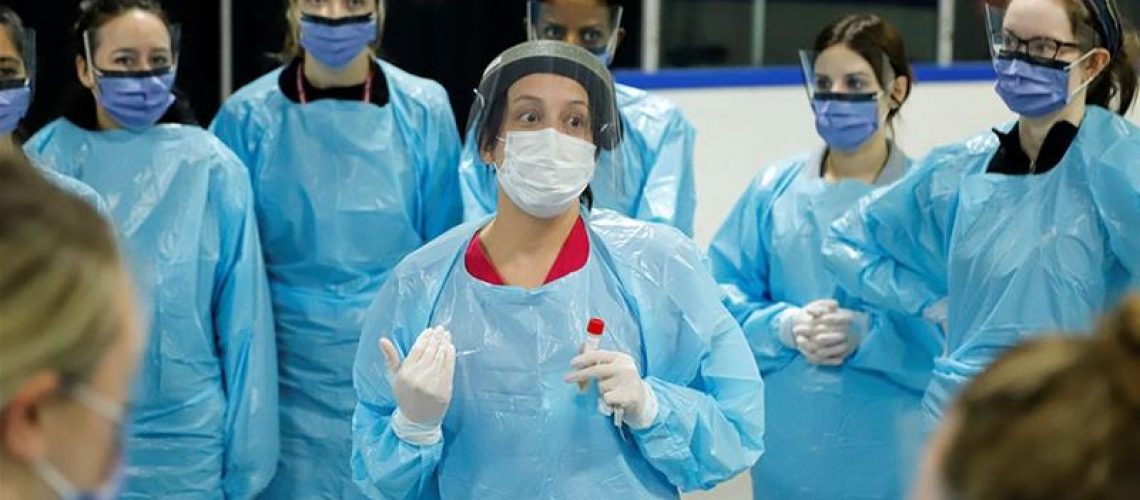WHO and CDC are recommending the use of FDA and EPA approved disinfectants to combat coronavirus. SARS-CoV-2, the virus that causes COVID-19, is new on the scene and R&D is still being conducted by organizations worldwide to determine how effective popular disinfectants are at killing this novel coronavirus.
Early results for killing SARS-CoV-2 with ozone are promising. According to EPA testing requirements, if an antimicrobial is able to kill a small non-enveloped virus, it will be effective at killing a large non-enveloped virus or any enveloped virus, like SARS-CoV-2, since enveloped viruses are easier to kill. Ozone has proven to kill much tougher viruses, including Canine Parvovirus, which is in the category of hardest to kill.
Indeed, recent studies published by Georgia Tech University (Ozone Disinfection Could Safely Allow Reuse of Personal Protective Equipment) found that “ozone can inactivate viruses on items such as Tyvek gowns, polycarbonate face shields, goggles, and respirator masks without damaging them.”
While we await further test results, historically effective disinfectants like ozone gas should be considered. Ozone has been used as a preferred disinfectant for over 120 years and is listed as an FDA and EPA approved disinfectant (PDF). It’s likely that the water you drink every day has been disinfected with ozone. The benefits of using ozone are that it is incredibly powerful at killing viruses and bacteria, often cited as over 3,000 times faster than bleach, and does so without the use of chemicals.
We are actively monitoring all the research being conducted and will continue to make the results known to our current clients and all those interested in acquiring our proven virus and bacteria-killing ozone technology for their PPE (personal protective equipment) and other sanitizing needs.
We have been receiving a lot of interest in the Fresh Gear RSS specifically related to the sanitizing of n95 masks and other medical PPE for reuse. Many have asked for our opinion. We cannot, and will not make a claim without appropriate evidence.
Here is what we have been sharing:
Based on years of study and practice we are very optimistic that the right amount of ozone would do a great job of sanitizing the various components of PPE. Have a look at this University of British Columbia study for further evidence of efficacy (PDF download).
The Fresh Gear ozone sanitizing machine reproduces the required environment that was utilized in the successful study, “Ozone gas is an effective and practical antibacterial agent”.
However, in order for a disinfecting device to be used in a hospital setting, it would need to be designated as a Class II medical device. While we are optimistic, Fresh Gear machines have not yet been submitted for this approval process yet.
Prior to the novel coronavirus emerging on the scene, our process was tested as to antimicrobial efficacy with the support of an independent laboratory. Bacteria counts under 1,000 CFU are generally considered as an acceptable level of infection risk. The tests we conducted were a worst-case scenario. It measured the pathogens, on the inside and outside of hockey gear, infected with bacteria counts in the hundreds of thousands of CFU (download PDF of the independent lab results here).
The right amount of ozone, over the appropriate duration, has consistently proven to achieve up to a 4 log kill of almost all pathogens tested.
A 30-minute cycle inside the machine would allow enough ozone to be generated, circulated, and then deactivated before the operator can open the door to remove the sanitized items inside.
In our opinion, it is the ONLY way to safely use a sufficient amount of powerful ozone gas to shock treat and thereby sanitize various types of PPE.
The stainless steel shelves inside are designed to be easily removed so that larger clothing items like firefighter coats or other exterior PPE could be hung from an adjustable length clothes rod extended to firmly attach to each side of the interior chamber walls. Really, any item of PPE or clothing could be treated in a similar method.
As an organization that has studied ozone’s disinfecting properties for over 15 years and have sanitized thousands of different items with ozone in the process, this is very likely one of the most effective ways to rapidly sanitize various PPE, and to do so completely chemical-free, making the items ready to wear upon removal from the machine.
We will communicate the results once testing has been completed.


